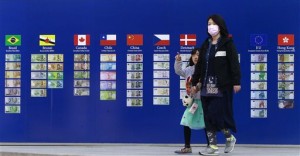As the March 31 application deadline for the Asian Infrastructure Investment Bank draws near, more countries are lining up to join the China-proposed bank.
So far, more than 40 countries have applied to be founding members ahead of the March 31 deadline, including Australia, Denmark, Egypt, South Korea, Britain, France, Germany, Italy, Luxembourg, Switzerland, India, and Singapore. The final number will be confirmed on April 15.
U.S. Treasury Secretary Jacob Lew said on Monday that the United States is looking forward to cooperating with AIIB, as it welcomes and supports proposals that are helpful to infrastructure construction. The cooperation can be carried out through the China-U.S. Strategic and Economic Dialog, the World Bank, and the AIIB, and any other mechanisms accepted by the two countries, Lew said in his talks with Chinese Premier Li Keqiang earlier on Monday, according to Chinese Vice Minister of Finance Zhu Guangyao.
“To me, (the AIIB) is a very important new concept that is really going to complement economic integration in Asia,” former Indonesian Trade Minister Mari Pangestu said.
“It is not about China’s dominance. It is about win-win cooperation.China needs to show that we are doing this because we want to play an international role in development,” she added.
Hans-Paul Burkner, chairman of the Boston Consulting Group, said there is enormous need for infrastructure investment, particularly in Asia due to the region’s rapidly growing population, and the need cannot be satisfied by the World Bank or Asian Development Bank alone.
“There will be cooperation and also some healthy competition with the ADB and the World Bank,” he said.
Ruan Zongze, vice president of the China Institute of International Studies, said the mission of the World Bank and ADB is to reduce poverty, while the aim of the AIIB is to finance infrastructure.
In addition, the World Bank and the International Monetary Fund work globally, while the AIIB focuses on Asia.
“Therefore, the tasks of the AIIB and existing institutions are complementary,” Ruan said.
Ruan said the drawbacks of the current international system, especially in the economy, are growing, and China is working to supplement the system rather than overturn it.
The funding demands for infrastructure are great in Asia, said Justin Yifu Lin, former chief economist and senior vice president of the World Bank, adding that the ADB predicted that eight trillion U.S. dollars will be needed in the region between 2010 to 2020.
Einar Tangen on challenges facing the “one belt, one road” initiative
For more on China’s economy, CCTV America interviewed Einar Tangen, current affairs commentator in Beijing.

Einar Tangen on challenges facing the
For more on China's economy, CCTV America interviewed Einar Tangen, current affairs commentator in Beijing.“But World Bank loans only cover less than five percent of the financing need every year,” Lin said, noting that outdated infrastructure has become a major bottleneck for economic development in Asian countries.
“The World Bank should be happy as the AIIB will help achieve a target that it can’t deliver on its own,” Lin said.
More importantly, said Zhu Min, deputy IMF managing director, the AIIB comes at a time when the global economy is struggling with slow growth and insufficient aggregate demand.
“The AIIB is expected to increase investment, boost demand and spur economic expansion in the region,” Zhu said.
Citing the huge financing gap for infrastructure in Asia, Zhu said the IMF views the AIIB as good news since it can help sustain Asian and global economic growth.
Source: Xinhua
 CGTN America
CGTN America A family member walks by a board showing foreign currencies in front of the head office of the Korea Exchange Bank in Seoul, South Korea, Friday, March 27, 2015. South Korea announced Thursday it will join the Asian Infrastructure Investment Bank, or AIIB, which is intended to help finance construction of roads and other infrastructure.(AP Photo/Ahn Young-joon)
A family member walks by a board showing foreign currencies in front of the head office of the Korea Exchange Bank in Seoul, South Korea, Friday, March 27, 2015. South Korea announced Thursday it will join the Asian Infrastructure Investment Bank, or AIIB, which is intended to help finance construction of roads and other infrastructure.(AP Photo/Ahn Young-joon)
